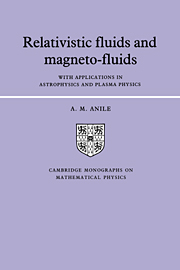Book contents
- Frontmatter
- Contents
- Preface
- 1 Introduction
- 2 Mathematical structure
- 3 Singular hypersurfaces in space-time
- 4 Propagation of weak discontinuities
- 5 Relativistic simple waves
- 6 Relativistic geometrical optics
- 7 Relativistic asymptotic waves
- 8 Relativistic shock waves
- 9 Propagation of relativistic shock waves
- 10 Stability of relativistic shock waves
- References
- Index
3 - Singular hypersurfaces in space-time
Published online by Cambridge University Press: 06 January 2010
- Frontmatter
- Contents
- Preface
- 1 Introduction
- 2 Mathematical structure
- 3 Singular hypersurfaces in space-time
- 4 Propagation of weak discontinuities
- 5 Relativistic simple waves
- 6 Relativistic geometrical optics
- 7 Relativistic asymptotic waves
- 8 Relativistic shock waves
- 9 Propagation of relativistic shock waves
- 10 Stability of relativistic shock waves
- References
- Index
Summary
Introduction
In the previous chapter we proved that, under suitable restrictions on the state equation, the equations of nondissipative relativistic fluid dynamics and magneto-fluid dynamics can be cast in the form of quasi-linear hyperbolic systems. A distinguishing feature of hyperbolic systems is the occurrence of nonsmooth solutions and in particular the generation of discontinuities in initially smooth profiles (Jeffrey, 1976). The physical interpretation of this phenomenon is that, in the absence of dissipation, the nonlinearity of the field equations tends to steepen a given initial profile until (if some conditions are met; Whitham, 1974) a discontinuity in some derivative of the field variables (or in the fields themselves) appears. Therefore, we must expect solutions with discontinuities to be a common occurrence in relativistic fluid dynamics and magneto-fluid dynamics. Due to the hyperbolic character of the equations the discontinuities will propagate as surfaces, called singular surfaces. This chapter is devoted to the study of propagating singular surfaces in a covariant framework. This provides the groundwork for the investigation of weak discontinuity waves in Chapter 4 and of shock waves in Chapters 8, 9, and 10.
A singular surface is a propagating surface across which the field variables characterizing the medium, and their derivatives, suffer a jump discontinuity (Truesdell and Toupin, 1960). When the fields themselves are continuous but some of their derivatives are discontinuous, the surface is called a weak discontinuity (or ordinary discontinuity) surface (Truesdell and Toupin, 1960; Jeffrey, 1976).
- Type
- Chapter
- Information
- Relativistic Fluids and Magneto-fluidsWith Applications in Astrophysics and Plasma Physics, pp. 57 - 70Publisher: Cambridge University PressPrint publication year: 1990

